دانلود مقاله High-Re Solutions for Incompressible Flow Using the Navier-Stokes Equations and a Multigrid Method, by U. GHIA, K. N. GHIA, AND C. T. SHIN, 1982
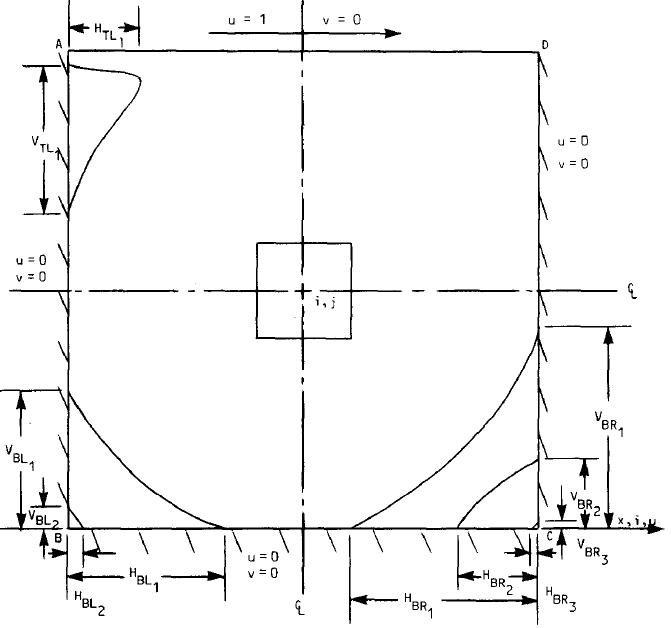
… این محتوا تنها برای اعضای ویژه و سطح مشخص می باشد.ورود ثبت نام...
دانلود مقاله Darcy Model for the Study of the Fluid Flow and Heat Transfer Around a Cylinder Embedded in Porous Media
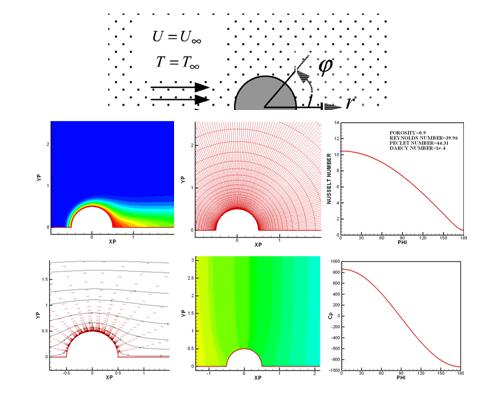
Steady-state convective heat transfer around a circular cylinder
embedded in porous media is studied in the range of low and
moderate Peclet numbers less than 40. The cylinder is at constant
temperature and the Darcy model is used for the analysis of fluid
flow and heat transfer in porous media. The governing equations
are discretised using finite volume approach based on staggered
grids. The powerlaw scheme is used in the numerical solution and
a SIMPLE-like algorithm is developed and used in the solution process.
It is found that the numerical algorithm is sufficiently efficient
in the range of Peclet numbers less than 40. Parametric studies are
done for better understanding of the porous media effects on the
Nusselt number distribution, pressure distribution, and flow and
temperature fields around a circular cylinder. The results are compared
with the available numerical data in the literature and have
shown good agreements.
دانلود مقاله تحلیل عددی انتقال حرارت جابجایی از یک هیت سینک پره پینیدار با پین های دارای مقطع بیضوی با یا بدون فوم فلزی بینابینی Numerical Analysis of Convective Heat Transfer From an Elliptic Pin Fin Heat Sink With and Without Metal Foam Insert
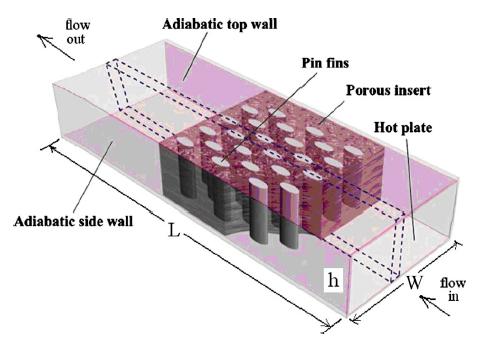
A numerical analysis of forced convective heat transfer from an elliptical pin fin heat sink
with and without metal foam inserts is conducted using three-dimensional conjugate heat
transfer model. The pin fin heat sink model consists of six elliptical pin rows with 3 mm
major diameter, 2 mm minor diameter, and 20 mm height. The Darcy–Brinkman–
Forchheimer and classical Navier–Stokes equations, together with corresponding energy
equations are used in the numerical analysis of flow field and heat transfer in the heat
sink with and without metal foam inserts, respectively. A finite volume code with point
implicit Gauss–Seidel solver in conjunction with algebraic multigrid method is used to
solve the governing equations. The code is validated by comparing the numerical results
with available experimental results for a pin fin heat sink without porous metal foam
insert. Different metallic foams with various porosities and permeabilities are used in the
numerical analysis. The effects of air flow Reynolds number and metal foam porosity and
permeability on the overall Nusselt number, pressure drop, and the efficiency of heat sink
are investigated. The results indicate that structural properties of metal foam insert can
significantly influence on both flow and heat transfer in a pin fin heat sink. The Nusselt
number is shown to increase more than 400% in some cases with a decrease in porosity
and an increase in Reynolds number. However, the pressure drop increases with decreasing
permeability and increasing Reynolds number.
دانلود مقاله مروری برمطالعات عددی هیدرودینامیک جریان توده ای (slug flow) و انتقال حرارت در میکرو لوله ها و میکروکانالها A review on numerical studies of slug flow hydrodynamics and heat transfer in microtubes and microchannels
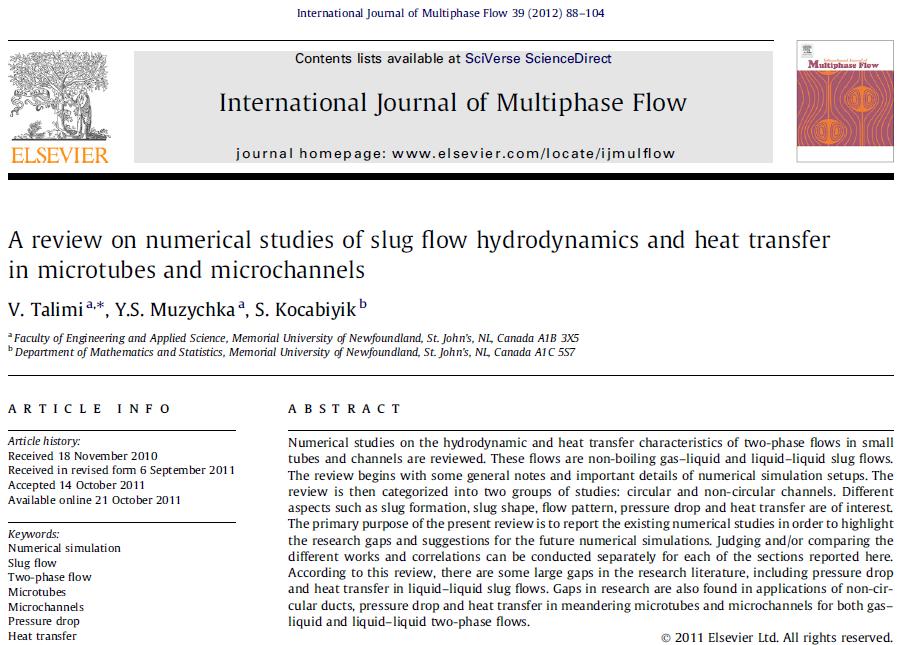
Numerical studies on the hydrodynamic and heat transfer characteristics of two-phase flows in small
tubes and channels are reviewed. These flows are non-boiling gas–liquid and liquid–liquid slug flows.
The review begins with some general notes and important details of numerical simulation setups. The
review is then categorized into two groups of studies: circular and non-circular channels. Different
aspects such as slug formation, slug shape, flow pattern, pressure drop and heat transfer are of interest.
The primary purpose of the present review is to report the existing numerical studies in order to highlight
the research gaps and suggestions for the future numerical simulations. Judging and/or comparing the
different works and correlations can be conducted separately for each of the sections reported here.
According to this review, there are some large gaps in the research literature, including pressure drop
and heat transfer in liquid–liquid slug flows. Gaps in research are also found in applications of non-circular
ducts, pressure drop and heat transfer in meandering microtubes and microchannels for both gas–
liquid and liquid–liquid two-phase flows.
دانلود مقاله مروری بر اثرات میدانهای مغناطیسی و میدانهای الکتریکی بر انتقال حرارت جوششی و شارحرارتی بحرانی(CHF) A Review on Effects of Magnetic Fields and Electric Fields on Boiling Heat Transfer and CHF

Taking advantage of electric fields and magnetic fields during boiling processes can be a very
beneficial way for enhancement of boiling heat transfer and increase of the critical heat flux
values. Applying magnetic fields and electric fields are promising active techniques which
contribute to higher heat flux accompanied by small wall superheat temperature. This paper
consist a complete review of published literature about effects of applying magnetic fields and
electric fields on heat transfer and critical heat flux during pool boiling and flow boiling
processes. The paper also includes the major affecting parameters and mechanisms reported in
the literature about the boiling heat transfer and critical heat flux in the presence of magnetic
fields and electric fields. The related achievements, results, inconsistencies and contradictions
existing in the literature are identified and discussed in detail. Some recommendations and
research directions for future studies are suggested.
دانلود مقاله مروری بر انتقال حرارت جوششی و رفتار لوله های گرمایی با سیالات دوباره مرطوب شونده (SRF)A review of boiling heat transfer and heat pipes behaviour with self-rewetting fluids
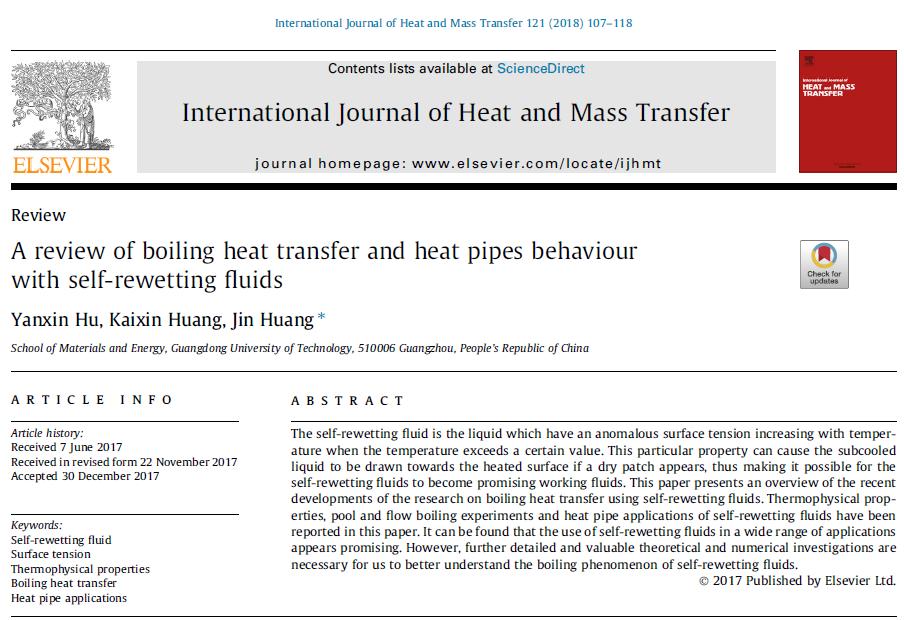
The self-rewetting fluid is the liquid which have an anomalous surface tension increasing with temperature
when the temperature exceeds a certain value. This particular property can cause the subcooled
liquid to be drawn towards the heated surface if a dry patch appears, thus making it possible for the
self-rewetting fluids to become promising working fluids. This paper presents an overview of the recent
developments of the research on boiling heat transfer using self-rewetting fluids. Thermophysical properties,
pool and flow boiling experiments and heat pipe applications of self-rewetting fluids have been
reported in this paper. It can be found that the use of self-rewetting fluids in a wide range of applications
appears promising. However, further detailed and valuable theoretical and numerical investigations are
necessary for us to better understand the boiling phenomenon of self-rewetting fluids.
دانلود مقاله مروری بر افزایش انتقال حرارت در جوشش با استفاده از مواد افزودنی/شناورسازها (سورفکتانتها)A review on augmentation of heat transfer in boiling using surfactants/additives
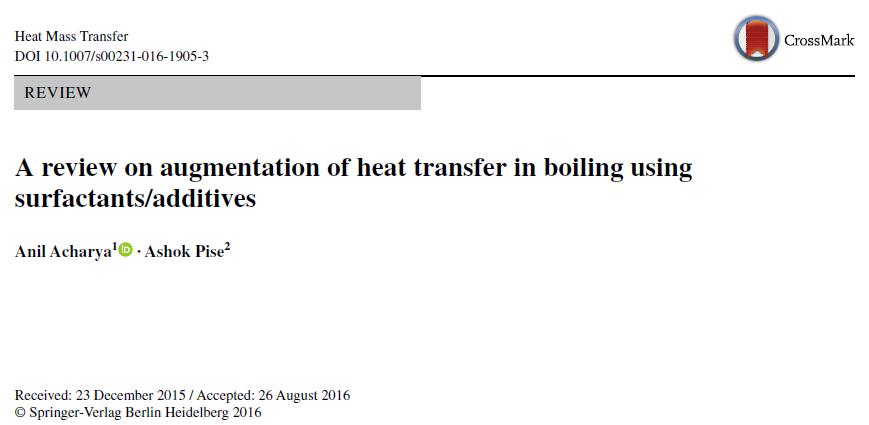
Studies of heat transfer enhancement in boiling
under various conditions and configurations have given different
results. Understanding the boiling behaviour from
these studies, literature is reviewed in terms of surface texture,
heater geometry and orientation, experimental and numerical
studies in presence of surfactant/additives. After understanding
different behaviour in boiling, the effect of environment
friendly surfactant is studied through literature review. Benchmarking
of experimental procedure is done by experimenting
and comparing some surfactants studied in literature.
دانلود مقاله مروری بر جوشش لایه ای در دماهای خیلی پایین A review of film boiling at cryogenic temperatures

Among the various modes of heat transport to liquids, film boiling is considered
to be an inefficient mechanism. However, in many practical engineering applications
it occurs. Consequently, film boiling must be studied and understood for design
applications. Film boiling is invariably encountered in quenching of metals, in
chilling of biological species, in regenerative cooling of rockets, and in cooling down
a cryogenic fuel tank, and occasionally film boiling can also happen in a nuclear
reactor or in a cryomagnet.
This paper will discuss what we know about film boiling and what future work
would be productive or of interest. The author will not attempt to cite every article
on film boiling that appears in the literature. Instead, the introductory portion of this
paper, which reviews what is known about film boiling, is designed to set the stage for
discussing those areas of film boiling where more study is needed.
The discussion will be divided into three parts: (1) film boiling of the unconstrained
liquid mass (Leidenfrost phenomenon); (2) pool film boiling; and (3) forcedconvective
film boiling inside a channel or tube.
دانلود مقاله مروری بر مدلسازی محاسباتی جوشش جریانی در میکروکانالها A Review of Computational Modelling of Flow Boiling in Microchannels

Flow boiling in microchannels has received enormous interest in academic research
over the past few decades because of its importance in the thermal management of
micro-structured devices. A vast number of experimental and theoretical studies have
been reported and an increasing number of computational studies of microchannel flow
boiling have been performed in the past few years. This article provides a review of the
previous studies of flow boiling in microchannels, with a focus on the computational
work. We present the governing equations, boundary conditions, numerical methods
and the mathematical treatment of phase change used. Some important numerical
studies are reviewed in detail and their strengths and weaknesses are presented. Finally,
a summary of the current status of modelling in this area is provided.
دانلود مقاله مروری بر مطالعه پارامتری انتقال حرارت در جوشش استخری نانوسیالها برای افزایش شار حرارتی بحرانی Parametric study of pool boiling heat transfer with nanofluids for the enhancement of critical heat flux: A review
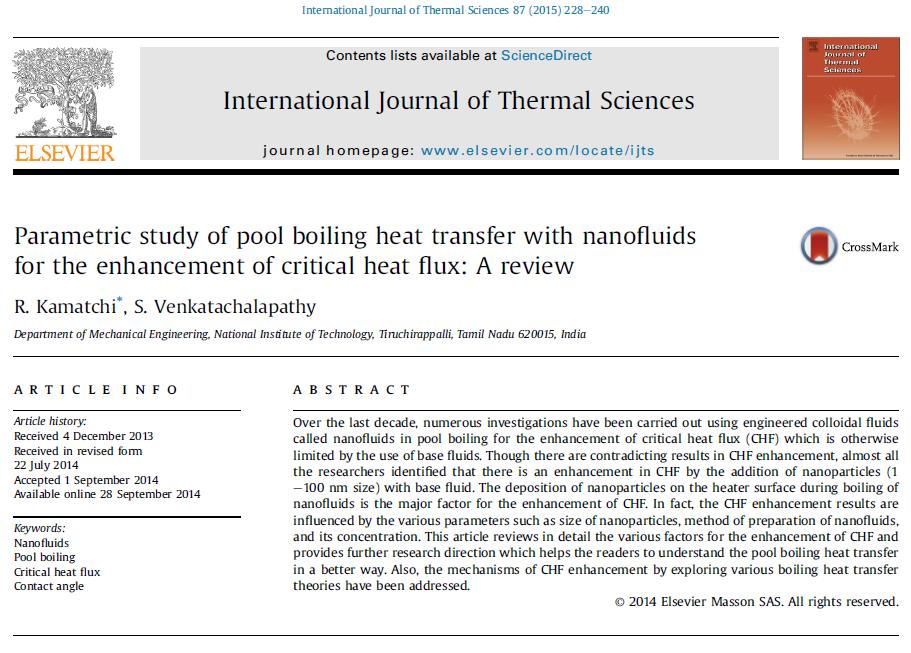
Over the last decade, numerous investigations have been carried out using engineered colloidal fluids
called nanofluids in pool boiling for the enhancement of critical heat flux (CHF) which is otherwise
limited by the use of base fluids. Though there are contradicting results in CHF enhancement, almost all
the researchers identified that there is an enhancement in CHF by the addition of nanoparticles (1
e100 nm size) with base fluid. The deposition of nanoparticles on the heater surface during boiling of
nanofluids is the major factor for the enhancement of CHF. In fact, the CHF enhancement results are
influenced by the various parameters such as size of nanoparticles, method of preparation of nanofluids,
and its concentration. This article reviews in detail the various factors for the enhancement of CHF and
provides further research direction which helps the readers to understand the pool boiling heat transfer
in a better way. Also, the mechanisms of CHF enhancement by exploring various boiling heat transfer
theories have been addressed.